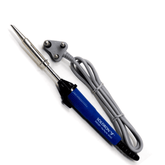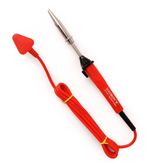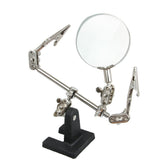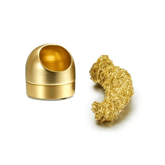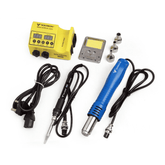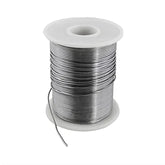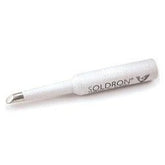Best Soldering Tools, Equipment, and Accessories
Summary
Soldering tools play a crucial role in the technology world, enabling the connection of various electronic components. Soldering involves using heat or an adhesive to form permanent bonds between two objects, and it is used for everything from creating circuit boards in computers to joining metal pipes. In this blog post, we have covered everything you need to know about Soldering. Unleash your creativity and join the soldering revolution today!
Introduction
Soldering tools are essential for professional quality results when building electronic components, repairing wires and circuitry, assembling circuit boards or joining two pieces of metal. The right soldering tool is critical to welding a joint properly and making sure it holds securely with minimal heat loss. Soldering irons come in many shapes and sizes, so it’s important to consider the job at hand before choosing one that matches your needs perfectly.
With all these considerations in mind, selecting appropriate solder wire requires skill – too thin solder won't be able to bridge gaps between contacts quickly enough while too thick will cause excess thermal stress on component pads resulting in permanent damage due to overheating!
What is Soldering?
Soldering is a process in which two or more objects are bonded by melting and inserting a filler metal into the junction, Filler metals are alloys or unalloyed metals that melt and liquefy when heated so that they can flow into the space between two closely spaced components to form a brazed or soldered junction. A filler metal has the right melting and flows characteristics to allow capillary attraction-based distribution in correctly constructed joints and also the filler metal has a lower melting temperature than the adjacent metal. Soldering does not entail the work components being melted as welding does.

Although neither the workpiece metal nor the filler metal melts in brazing, the filler metal does melt at a higher temperature than in soldering. Nearly all soldiers used to contain lead, but environmental and health concerns have forced an increase in the usage of lead-free alloys in electronics and plumbing. Copper is the primary material used to make wires, component leads, and tracks for circuit boards. A thin layer of tin is typically applied to copper to both prevent oxidation and improve the bonding of solder to other components. To "tin" bare copper wires before soldering, molten solder is frequently applied to them.
For various uses, soldering filler materials come in a wide range of alloys. The eutectic alloy containing 63% tin and 37% lead (also known as 60/40, which has a melting point nearly identical to that of 60/40) has traditionally been used in electronics construction. Plumbing, mechanical assembly, and other uses call for the usage of different alloys. Tin-lead for general use, tin-zinc for joining aluminium, lead-silver for strength above room temperature, cadmium-silver for strength at high temperatures, zinc-aluminium for aluminium and corrosion resistance, and although neither the workpiece metal nor the filler metal melts in brazing, the filler metal does melt at a higher temperature than in soldering. Nearly all soldiers used to contain lead, but environmental and health concerns have forced an increase in the usage of lead-free alloys in electronics and plumbing. Copper is the primary material used to make wires, component leads, and tracks for circuit boards. A thin layer of tin is typically applied to copper to both prevent oxidation and improve the bonding of solder to other components. To "tin" bare copper wires before soldering, molten solder is frequently applied to them.
What is the difference between Welding and Soldering?
There are several methods for joining two or more pieces of metal, and occasionally other materials, including brazing, soldering, and welding. They can also be used to fill voids in metal parts. So how can you choose which method to employ? The material, desired strength, and application all play a role in that choice. Let's discuss,
- Welding is a process in which two or more components cool and it involves the use of heat, pressure, or both. The most common materials for welding are metals and thermoplastics, however, wood can also be utilised. A weldment is a term used to describe the finished welded junction.
- Welding is a high-heat procedure that melts the base material, as opposed to brazing and soldering, which do not. usually with the use of a filler substance.
- High-temperature heat creates a pool of molten material during welding, which then cools to form a connection that may be stronger than the parent metal. Along with the heat, pressure can also be employed to create a weld.
- Two metals must be comparable to be welded together. For instance, copper and steel cannot be welded.
- For two metals to melt and fuse during welding, a very high temperature is required.
- When welding, you frequently utilise a filler material, which is an additional piece of metal that fills in any gaps.
- If the welding work was done correctly, the weld should be just as strong as the metal it is joining. For instance, using too much heat can alter the properties of the metal and weaken the weld.
- varying welding methods: Depending on the type of metal you work with, there are several welding processes. You can learn which technique to utilise with which type of metal in a welding programme.
- The strongest joints used to carry the weight are those created during welding. The welded component of a joint typically has a strength greater than the base metal. For soldering electrical joints are used.
- The recommended temperature for welding joints is 3800°C. The temperature required for soldering is 450°C.
- Workpieces must be heated to their melting point to be joined. In soldering it's not required.
- Base metal's mechanical characteristics may alter at the junction as a result of heating and cooling. In soldering no need to change mechanical properties.
- In most cases, heat treatment is necessary to remove the unfavourable effects of welding. Since welding is done at high temperatures, the workpiece does not need to be preheated. But in soldering, it's beneficial to pre-heat workpieces before soldering to create joints of high quality.
Types of Soldering
One of the most fundamental skills needed to manage electronic projects is soldering. Beginners may certainly work with breadboards and other basic components, but once they understand how to solder, a whole new world of creative ideas and possibilities opens up to them. PCBs are a little trickier to work with than breadboards, and novices especially need to learn how to solder. For electronic engineers, we have developed some soldering advice and guidelines. Therefore, if you are hesitant to even hold a soldering iron, following these dos and don'ts will undoubtedly benefit your efforts.

Soft Soldering
The process of soft soldering is used to repair very small compound parts with low melting temperatures that have been damaged during the high-temperature soldering process. A tin-lead alloy is utilised in this technique as the space filler metal. The space filler alloy's melting point cannot be lower than 400oC or 752oF. The heat source for the process is a gas torch. Tin-zinc for bonding aluminium, tin-lead for general use, zinc-aluminium for aluminium, cadmium-silver for power at high temperatures, lead-silver for strength above room temperature, weakening confrontation, tin-silver & tin-bismuth for electrical products are a few examples of this type of soldering metals.
Its purpose is to dissolve oxides that have accumulated on metal surfaces during the healing process or to avoid oxidation of the surfaces to be soldered. The most popular soldering flux is zinc chloride, despite being corrosive. Although the resin is non-corrosive, it lacks zinc chloride's ability to clean. A blow torch or soldering iron is created, which is a tool for melting flux and melting the solder on base metals.
Hard Soldering
Hard soldering is the method by which a solid solder fills in the holes of the component that has become unlocked as a result of the high temperature. The metal used as a gap filler can withstand temperatures of greater than 450oC/840oF. There are two components to it: silver and brazing soldering.
Silver Soldering
It uses stronger solder than that used in soft soldering, which melts at greater temperatures. Hard soldering techniques like silver soldering use a solder made of silver and tin. The temperature range for different types of hard solder is roughly 600 to 900°. The fluxes are typically applied to the joint using a brush and heated before being in paste form. The tool used in hard soldering is a blowtorch.
Braze Soldering
Compared to the metals used in hard and soft soldering, these forms of soldering metal have a much greater melting point. The metal being joined is heated rather than melted, which is identical to hard soldering. The soldering metal, which melts and serves as a bonding agent, can then be placed between the two materials once they have been heated to the proper temperature.
Methods of soldering:
- Flame soldering
- Furnace brazing
- Electrical resistance soldering
- Induction soldering
- Reflow soldering
- Laser soldering
- Hand soldering
1. Flame soldering:
Aluminium cooling segments are soldered using a flame soldering machine. The interfaces of the cooling elements are hard-soldered. A hydrogen flame heats the soldering spots, melting the solder with incorporated flux. At various joints, automatic soldering occurs simultaneously.
2. Furnace brazing:
Different lower filler metal is used to braze together metal components in a semi-automated procedure. Design and production experts can combine simple or complicated designs of a single joint or multiple joint assemblies using furnace brazing.
3. Electrical resistance soldering:
Resistance Soldering is the term used to describe a method in which the heat necessary to melt solder is instantly produced by running a strong electrical current through a resistant material.
4. Induction soldering:
Through the method of induction soldering, two or more metal components are connected by melting and flowing a filler metal (solder) into the joint interface. The workpieces being assembled have a higher melting point than the filler metal (solder).
5. Reflow soldering
Reflow soldering creates sturdy junctions that are dependable. The joints are robust because they are not subjected to temperature shock. Additionally, they require little oversight because the process is carried out under regulated circumstances. Surface mount component soldering is best done using the reflow soldering technique.
6. Laser Soldering:

With the help of a well-focused laser beam, a solder alloy is heated under controlled conditions, creating a quick and non-destructive electrical bond. By absorbing laser light that is delivered in the form of a moderately focused laser beam, laser soldering makes use of extremely regulated heating. For fine soldering applications in microelectronics, for example, the laser beam diameter is frequently much below 1 mm, although it can also be a few millimetres for some soldering procedures on bigger items.
7. Hand Soldering:
The simplest and most popular soldering technique in electrical engineering is hand soldering. Here, pressure is applied using a soldering iron's pre-tinned soldering tip to heat the components that need to be linked and melt the solder. Soft soldering is another name for this method.
Tools used in soldering:
- Soldering iron
- Soldering station
- Iron tips
- Brass or conventional sponge
- Soldering iron stand
- Solder
- Helping Hand
1. Soldering Iron

The most fundamental soldering tool, which resembles a pen, is a soldering iron. Beginners use this for do-it-yourself soldering tasks like soldering PCBs and other electronic components. First, turn on the gadget and heat the iron's tip.
2. Soldering Station

A soldering station is a comprehensive set that contains all the necessary soldering tools. Soldering irons, air compressors, and de-soldering equipment are some of the usual tools. Since a soldering station allows you to precisely control the soldering tip's temperature, it is frequently used to solder delicate electronic components. The temperature must be set to the lowest setting and the soldering station must be plugged into an electrical outlet. The temperature must be raised gradually until the solder melts.
3. Iron tips

The iron's tip heats up and causes the solder to flow around the two components to be bonded. Contrary to popular assumption, the tip does not transfer solder; rather, it transmits heat, which raises the temperature of the metal components and causes the solder to melt. A soldering iron's tip can frequently be adjusted based on the situation. The three main types are conical, and chisel.
4. Brass or conventional sponge

The tip tends to oxidise and turn black over time from constant use, which prevents it from taking solder. To clean the tip and keep it from wearing off, a sponge is used.
5. Soldering Wire

Soldering wire is the alloy that is typically sold as a length of thin, long wire in tubes or spools. In normal form, solder contains lead, tin, and a few additional trace metals. However, due to the negative consequences of lead, a different type of lead-free solder was eventually produced and is now utilized in several nations.
Advantages of soldering
- Lower Heat
- Does Not Warp
- Soldering tools facilitate the conduction of electricity, allowing for multiple connections simultaneously, especially in circuit boards submerged in a solder bath
- The soldering iron only requires a small amount of power to heat up.
- Parts with thin walls can be linked.
- An easily mechanised process.
- Material of different types can be connected.
- Low power was needed for this procedure.
- Soldering is an easy process to regulate at low temperatures.
- There are no residual strains or thermal distortion in the joint members.
- The microstructure is insensitive to heat.
Disadvantages of soldering:
- Certain soldering tools may become less effective when joints operate at high temperatures, impacting their overall strength.
- Heavy pieces cannot be joined by the soldering method.
- It is only appropriate for little pieces.
- It is useless for welding long distances.
- This process cannot be used in the heavy metals.
Application of soldering:
- Soldering in plumbing
- Soldering in vacuum tubes
- Soldering in Jewellery
- Home Projects
- Soldering for electrician
- Soldering for plastic circuit board
- Soldering in roofing business etc.
Conclusion
In this blog post we have learnt soldering is a crucial process in electronics and metalwork that involves joining two metals by using a filler metal with a low melting point. The distinction between soldering and welding lies in the temperature and the type of materials used. There are various methods and tools of soldering, each having its own advantages and applications. For electronics enthusiasts, metalworkers, or DIY hobbyists, exploring the world of soldering tools and understanding their basics can unlock a multitude of possibilities for your projects. Start your soldering journey today and unleash your creativity!
If you appreciate our work don't forget to share this post and leave your opinion in the comment box.
Please do check out other blog posts about Popular electronics
Make sure you check out our wide range of products and collections (we offer some exciting deals!)



